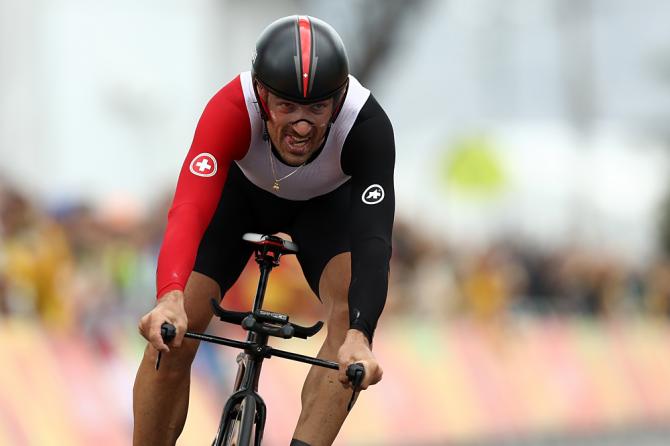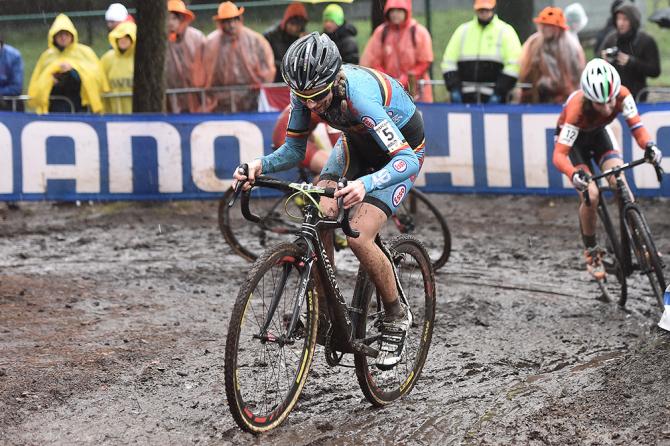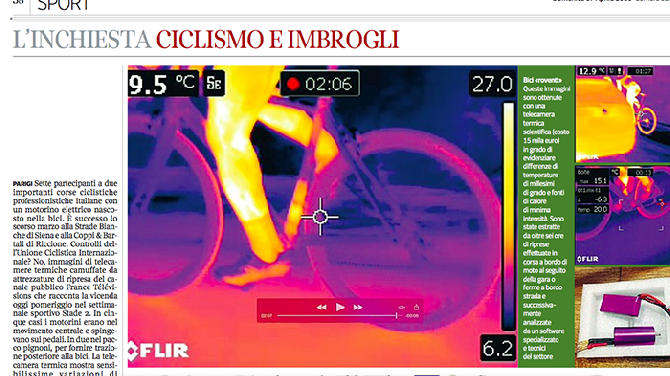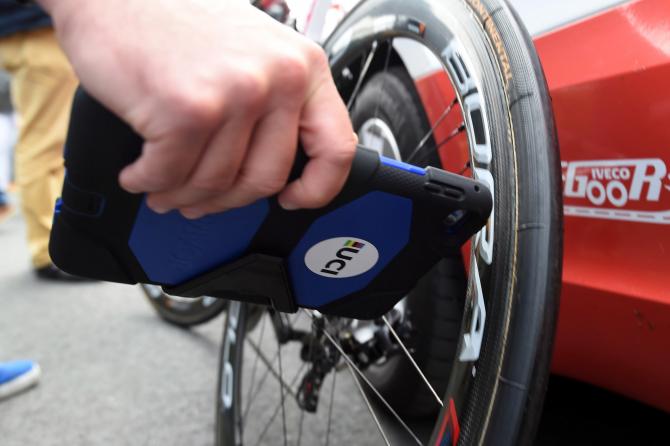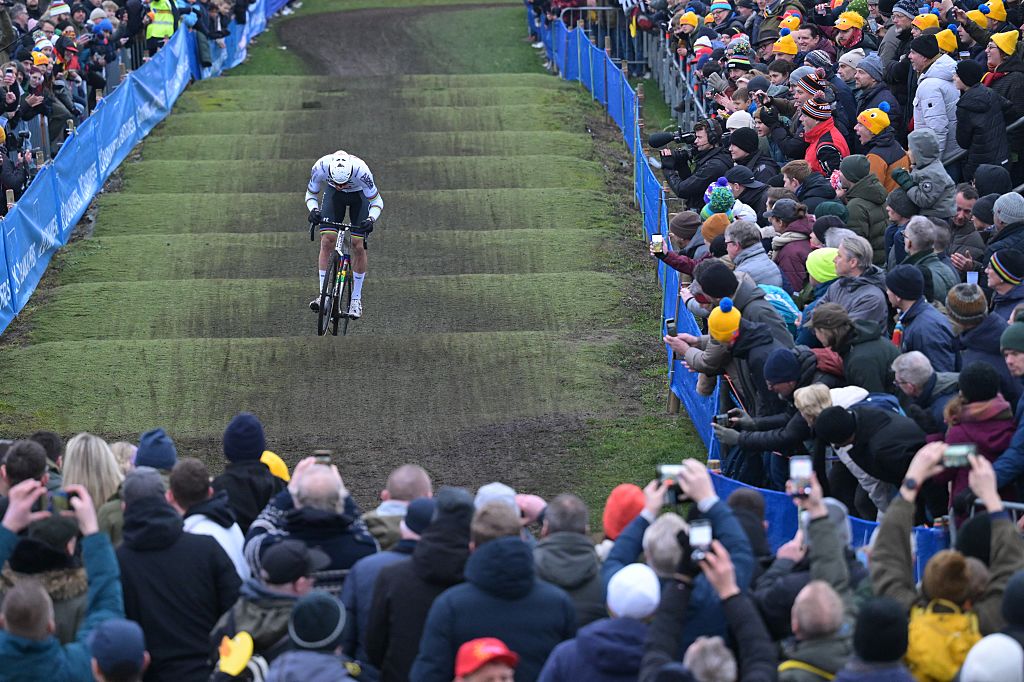Mechanical doping: A brief history
Everything you need to know about mechanical doping
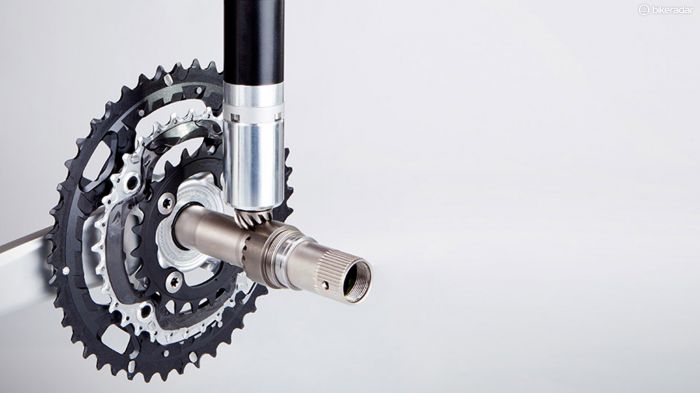
What is mechanical doping? The UCI officially calls it ‘technological fraud’ and introduced regulations last January that could see a rider given a minimum suspension of six months and huge fines if riders and teams are caught using a hidden motor in their bikes to boost their performance.
UCI confirms motorised doping uncovered at cyclo-cross World Championships
Femke Van den Driessche denies using motor at cyclo-cross World Championships
Electromagnetic wheels are the new frontier of mechanical doping, claims Gazzetta dello Sport
Wilier Triestina to take legal action after motor found in bike at cyclo-cross Worlds
Froome calls on UCI to increase checks for motors
Cancellara curious to see how motor investigations unfold
Van den Driessche’s friend claims ownership of motorised bike
UCI needs to take fast and tough action in motorised doping case, says European Cycling Union
Cookson on mechanical doping: Don’t delude yourself that we haven’t been taking this seriously
UCI sends Van den Driessche’s mechanical doping case to Disciplinary Commission
UCI search for mechanical doping at the La Mediterraneenne race
UCI checks 90 bikes for mechanical doping at La Méditerranéenne
Mechanical dopers should be heavily punished, says CPA
139 mechanical doping checks carried out at Omloop Het Nieuwsblad
Van den Driessche stops defence against mechanical doping charge
Mechanical doping used in Strade Bianche and Coppi e Bartali, claims investigation
Mechanical doping: UCI commissaire highlights legal grey areas
Mechanical doping: Bettini calls on UCI to use thermal cameras at Giro d'Italia
Contador backs lifetime ban for mechanical doping
Boonen: Mechanical doping is the lowest of the low
UCI reveals technology used to detect mechanical doping
Cookson answers questions about mechanical doping - Video
Stade 2 programme claims UCI tipped off others about police investigation into mechanical doping
Thermal cameras to detect mechanical doping spotted mid-stage - Tour de France Shorts
Mechanical doping inventor promises major revelation in January
CBS 60 Minutes investigates mechanical doping in professional cycling
Tour de France to continue thermal imaging checks for mechanical doping
CBS 60 minutes to broadcast investigation into mechanical doping on Sunday
Claims of mechanical doping at the Tour de France in CBS 60 Minutes investigation
Bruyneel blasts LeMond for 'obsession' with Armstrong and mechanical doping
53-year-old amateur rider caught using hidden motor at Italian race
Italian amateur denies using mechanical doping
Report: Four ways to hide motor doping in a race bike
Doubts raised over effectiveness of UCI tests for mechanical doping
UCI's mechanical doping tests called into question - Video
UCI defends mechanical doping testing procedure
French veteran rider reportedly caught using mechanical doping
The early kinds of motors were rudimentary and hidden in the seat tube but more sophisticated examples based on Formula 1 and Eastern Block military technology apparently involve hidden magnets in wheels which are much more difficult to detect.
The UCI was left embarrassed at their own cyclo-cross World Championships when they discovered a rudimentary motor hidden in the bike of Belgium’s Femke Van den Driessche before the women’s race. She was eventually banned for six years.
The existence of mechanical doping began as a whisper back in 2010 with suggestions of riders using hidden motors in professional races. Fabian Cancellara was at the centre the social media storm after he rode away from Tom Boonen on the steepest part of the Kapelmuur in the Tour of Flanders, leaving the Belgian commentators stunned at the force of his acceleration while seated. Cancellara always angrily denied the accusations. In 2014 and 2015 further suspicions of mechanical doping arose again, with video footage of spinning wheels fuelling the rumours via social media.
In 2016 the French television show Stade 2 and Italian newspaper Corriere della Sera carried out a detailed investigation and claimed that hidden motors had been used in several spring races.
The UCI played down the investigation but was forced to up its controls and also began to use x-rays at the Tour de France. However the suspicions continued to surface with Istvan Varjas, the Hungarian engineer believed to have invented the hidden motor technology, claiming that used mechanical doping had been used in the past and that the technology has developed and improved over the years.
What is mechanical doping? - July 16, 2015
The latest race content, interviews, features, reviews and expert buying guides, direct to your inbox!
It was the first wide-spread reporting on the technology that some denied existed - tiny motors that could add watts to a rider's pedal stroke. The battery-driven device sits in the bottom bracket area, and helps propel the crank arms around. The rider still needs to pedal, but an assist of even just 50 watts could be a race-winning amount.
UCI denies reports of motorised doping - May 19, 2010
Even UCI President Pat McQuaid denied the technology would be in practical use in the pro peloton.
“We do not have any knowledge if this product is already in use in competitive cycling,” he said at the time. “At this point in time, we don’t have any evidence that leads us to the conclusion that this kind of engine is already in use in the peloton."
Lefevere takes mechanical doping seriously - June 01, 2010
Boonen's Quickstep team manager, on the other hand, took the allegations seriously. "It would be worse than doping,” Lefevere said. “Even pure theft.”
UCI to discuss 'motorised doping' issue - June 02, 2010
Eventually the UCI was forced to consider the possibility, even though McQuaid continued to deny that it would be practical. "They are still not invisible," he said. "All the evidence we're seeing . . . is that the battery is about the size of a bag of sugar."
Team Saxo Bank rejects insinuations of mechanical doping - June 03, 2010
Cancellara's team staunchly defended their rider with an emphatic statement:
"There was not and never has been a motor in any Team Saxo Bank rider's bike," the team wrote. "Fabian's victories are the result of dedication, hard work and sacrifice as well as his unique ability to rise to the occasion when striving to reach his goals. We are confident that the public can see through the nonsense this myth has presented and respect Fabian for what he is. A true Champion."
Boardman warned the UCI of risks of bike doping - June 04, 2010
As the discussions carried on, Chris Boardman chimed in to say he'd warned the UCI about the motors a year before the rumors even started.
"I sat at a meeting with the UCI last year and drew on the blackboard exactly how this might work," Boardman told the Telegraph. "I showed them some of the sophisticated boosting technology now available, mainly from F1 teams, that can get a kilowatt out of a single AAA battery. And don't forget electrically operated gears are legal these days so there is already a power source on many bikes. I think it would be fair to say there was a stunned silence after I said my piece."
Cancellara: My body is my motor - June 11, 2010
Cancellara still maintained that the only engine he has is his body.
UCI to start bike scanning - June 19, 2010
The UCI decided that they should start checking the bikes, beginning with the Tour de France, stating it is “necessary to bolster measures that have already been put in place". In addition to visual inspection, they brought in scanners to check for motors.
UCI check 36 Milan-San Remo bikes for motors - March 23, 2015
Checks continued in the Spring Classics, with 11 bikes from Trek Factory Racing, Etixx-Quickstep and TInkoff-Saxo being examined in a special area set up by the UCI.
UCI introduces new sanctions against motorised doping - April 30, 2015
The UCI set down rules for technological fraud, as they call mechanical doping, giving riders a minimum of six months ban and a fine of between 20,000 and 200,000 Swiss Francs. Teams can also face disqualification, a suspension of at least six months and a fine of between 100,000 and 1 million Swiss Francs.
Contador responds to Cipollini’s doubts about motors and bike changes - May 15, 2015
Giro d'Italia winner Alberto Contador raised suspicions by taking some oddly timed bike changes in the race. With all the rumors swirling around motors, some assumed he was using the swaps to get on a bike with a motor, to which he responded: "The whole thing about motors is a joke, it comes from the world of science fiction. The changes depend on how the stage unfolds, we can use different type of tubulars, bearings or even stiffer wheels. These are solutions that over 30-40km can give a slight advantage. It’s got nothing to do with motors."
Video: UCI checks Alberto Contador's bike for motor - May 29, 2015
UCI officials disassembled Contador's bike and find nothing.
UCI serious about mechanical doping but number of tests remain low - July 25, 2015
The UCI reiterated its seriousness about the issue, but only ran a few checks at the Tour de France.
UCI test Froome, Contador and Pinot bikes on Alpe d'Huez for mechanical doping - July 26, 2016
Cyclingnews got a look inside the testing process, and found that the UCI was not only looking for motors hidden in the frames, but devices in the wheels as well.
LeMond: The UCI should use a heat gun to detect motors - May 29, 2015
Greg LeMond believed the rumors, and gave some practical advice to the UCI: “I know that motors exist, I’ve ridden a bike with one and I’ve met the inventor and talked about it. If people think they don’t exist, they’re fooling themselves, so I think it’s a justified suspicion. I believe it’s also been used in the peloton. It seems too incredible that someone would do it, but I know it’s real. It’s simple to check for, much easier than doping, but not by looking down the tube. You need a thermal heat gun, you can use it in the race. It can see from metres away if there a difference in the heat in the bottom bracket. I’d recommend that to the UCI.”
UCI investigates possible bike fraud at cyclo-cross Worlds - January 30, 2016
The first hint of a motor being found came from the U23 women's race at the UCI Cyclo-cross World Championships in Zolder, Belgium when the UCI seized Belgian Femke Van den Driessche's bike from the pits.
UCI confirms motorised doping uncovered at cyclo-cross World Championships - January 31, 2016
The UCI confirmed both that a motor had been found in a bike from Van den Driessche's pit area, and that they have been using new detection methods - rumoured to be a tablet app. "To all the people who want to cheat, yesterday we sent a clear message: we will catch you and we will punish you because our technology to detect such fraud seems to work,” UCI president Brian Cookson said.
Froome calls on UCI to increase checks for motors - February 02, 2016
"For the last few years now there have been rumours about motors being concealed within the bikes. It's a concern that I've had, something that I've brought up with the UCI Independent Commission when I sat down with them and said ‘listen, from my point of view there are these rumours, it would be my advice that the UCI implements controls and measures to start checking bikes more regularly'," Froome said.
Wiggins sure motor doping has been going on for some time - February 02, 2016
“For five years now they’ve had this suspicion because they’ve been checking the bikes. I think it is the first one they’ve found, but I’m sure that it has happened in the past, but they haven’t found them."
Electromagnetic wheels are the new frontier of mechanical doping, claims Gazzetta dello Sport - February 01, 2016
The Italians were again at the forefront of news on mechanical doping, stating that motors in frames were old technology.
“A motor hidden in the seat tube is old stuff, almost artisan. It’s been overtaken, it’s a poor man’s doping,” Gazzetta dello Sport's Claudio Ghisalberti wrote. “The new frontier is far more technologically advanced and ten times as expensive. It’s in the rear wheel: it costs 200,000 Euros, and there’s a waiting list of six months. The first type uses a motor to turn the cranks; the second is electromagnetic.”
Mechanical doping and what it means for cycling - Cyclingnews Podcast - February 03, 2016
Mechanical dopers should be heavily punished, says CPA - February 16, 2016
CPA President Gianni Bugno said that mechanical doping is hardly a problem in the pro road peloton, and supported the UCI's efforts. "We are convinced that the UCI is doing its best to improve and refine the controls and we hope there will be a progress, with the cooperation of manufacturers, in order to remove any doubt about the athletes' performances. We, too, within our association, are looking for solutions to make controls the most precise and quick as possible and we know we can count on the full cooperation of the riders," Bugno said.
Read more:
- 139 mechanical doping checks carried out at Omloop Het Nieuwsblad
- UCI continue checks for mechanical doping at Tirreno-Adriatico - News Shorts
- UCI checks all Tirreno-Adriatico time trial bikes for mechanical doping
- UCI check ten teams for mechanical doping at Paris-Roubaix
Mechanical doping used in Strade Bianche and Coppi e Bartali, claims investigation - April 17, 2016
A joint investigation into mechanical doping by French television programme Stade 2 and Italian newspaper Corriere della Sera claimed that the UCI's tablet is ineffective, and purported to have evidence using thermal cameras that there have been motors used in the professional peloton - as recently as Strade Bianche and the Coppi e Bartali. The investigation showed technology that hides motors inside the rims of deep dish carbon wheels.
UCI reacts to criticism in French and Italian media mechanical doping investigation - April 17, 2016
The UCI rejected criticisms that its tablet device is ineffective in detecting motors, stating, "We have looked at thermal imaging, x-ray and ultrasonic testing but by far the most cost effective, reliable and accurate method has proved to be magnetic resonance testing using software we have created in partnership with a company of specialist developers. The scanning is done with a tablet and enables an operator to test the frame and wheels of a bike in less than a minute."
Femke Van den Driessche banned for six years for mechanical doping – April 26
The UCI confirmed that Femke Van den Driessche has been banned for six years for mechanical doping. The ban is backdated to October 11, 2015, and she must also pay a fine of 20,000 Swiss francs.
“This decision follows the discovery of a concealed electric motor in one of the rider’s bikes during checks at the Women Under 23 race of the UCI Cyclocross World Championships in January 2016. The bike concerned was scanned using the new magnetic resonance testing deployed this year by the UCI. This detected the motor whilst the bike was in the rider’s pit area. The motor was a Vivax which was concealed along with a battery in the seat-tube. It was controlled by a Bluetooth switch installed underneath the handlebar tape."
UCI reveals tablet technology used to detect mechanical doping – May 3
The UCI has revealed details of the tablet technology it uses to check for mechanical doping during a special demonstration to selected media, including Cyclingnews, at the UCI Headquarters in Aigle, Switzerland.
UCI Technical Manager Mark Barfield and UCI President Brian Cookson reiterated their belief in the use of the tablet device to detect magnetic flux density of hidden motors or magnetic wheels. The UCI clearly wanted to send out a strong message of deterrent to anyone thinking of using mechanical doping in the sport.
UCI uses x-ray machine to search for mechanical doping at the Tour de France - July 10
The UCI has always insisted that its tablet device is the best way to check for mechanical doping but the sport's governing body begun to use a simple thermal camera during key stages of the Tour de France and is also using X-ray machines to check for hidden motors or special wheels.
Cyclingnews spotted the UCI carrying out X-rays of several bikes after the stage despite the heavy rain and cold conditions. Both of Chris Froome's race bikes were checked using the mobile X-ray set-up, as was Peter Sagan's bike. A UCI official told Cyclingnews that 10 bikes were X-rayed but did not specify who the bikes belonged too.
Brailsford defends Froome after questions about mechanical doping – July 11
Team Sky manager Dave Brailsford hit back at a question hinting that Chris Froome may have gained significant time on his Tour de France rivals because of an increase in testing for mechanical doping.
When a British journalist said that a 'French friend' had suggested to him that extra bike checks – including x-rays – had somehow acted as a deterrent, Brailsford hit back at any kind of Chinese whispers journalism.
"Finding an engine in a bike is a pretty simple thing to do in this day and age," Brailsford said bluntly, raising his voice.
"If your friend is asking about thermal imaging or whatever, tell him to get one himself and come and have a look. Froome's bike has been tested more than everyone else's, we get tested every day. We actually had an email from the UCI saying thank you for being the most cooperative team out of everybody when it comes to bike checks and mechanical checking.
No cases of mechanical doping discovered at Tour de France says UCI – July 27
The UCI confirmed that no cases of mechanical doping were discovered during the Tour de France after 3773 tests were carried out using the famous blue magnetic resistance tablet, with other checks done via thermal imaging in race and with x-rays at the end of a number of key mountain stages.
The UCI claimed that over 10,000 checks have now been carried out in different disciplines and in different gender and age categories. To date, only one case of mechanical doping has been revealed and sanctioned after a rudimentary hidden motor was discovered in one of the bikes of Belgian under 23 rider Femke Van den Driessche at the 2016 UCI Cyclo-cross World Championships in Zolder in Belgium.
Lance Armstrong denies ever using mechanical doping – October 8
Lance Armstrong has denied ever using a hidden motor in his bike during his professional career, asking interviewer Ger Gilroy of the Irish Off the Ball radio show: "Are you out of your mind? I know its topical but are you crazy?"
Armstrong flatly denied ever using a motor, saying "Absolutely not." He said he knew that motors were a hot topic in the sport after a series of revelations in recent months but claimed that in 1999 nobody even knew it was possible to put a motor in a bicycle.
UCI refutes mechanical doping allegations, Motors in use since 1999? A 'big story' coming soon – October 14
The UCI has refuted claims that it may have obstructed French police in their search for mechanical doping at this year's Tour de France.
Istvan Varjas, the Hungarian engineer believed to have invented the hidden motor technology used for mechanical doping, claimed during a radio interview that he explained how to find hidden motors to French police but that the UCI "refused to allow them to check the bikes".
"This is the scandal - not if they're being used or not used. If there is an organisation that is supposed to stop this problem, and they don't do it, I think they are complicit or something like this," Varjas added.
The Varjas interview with journalist Ger Gilroy of the Irish Off the Ball radio show revived the fear that mechanical doping has long been a problem in the professional peloton. He confirmed that he sold one of the first prototypes of a motor at the end of 1998, under an agreement that he could not talk about or share the technology for 10 years.
"Very soon you will see a big story, I think," he said. "You will see. It's a documentary; it's not a tale. They get all the evidence and witnesses under oath. They made it under oath in America with some people. You will be seeing it very soon. After this comes out I can talk more, but they paid me for exclusivity for this report."
- Mechanical doping inventor says UCI obstructed police attempts to find cheaters at this year's Tour de France - October 13, 2016
- Mechanical doping inventor promises major revelation in January - December 16, 2016
- CBS 60 Minutes investigates mechanical doping in professional cycling - December 28, 2016
- Tour de France to continue thermal imaging checks for mechanical doping - January 17, 2017
- CBS 60 minutes to broadcast investigation into mechanical doping on Sunday - January 27, 2017
- Claims of mechanical doping at the Tour de France in CBS 60 Minutes investigation - January 30, 2017
- Bruyneel blasts LeMond for 'obsession' with Armstrong and mechanical doping - February 8, 2017
- 53-year-old amateur rider caught using hidden motor at Italian race - July 30, 2017
- Italian amateur denies using mechanical doping - July 31, 2017
- Report: Four ways to hide motor doping in a race bike - August 1, 2017
- Doubts raised over effectiveness of UCI tests for mechanical doping - September 3, 2017
- UCI's mechanical doping tests called into question - Video - September 4, 2017
- UCI defends mechanical doping testing procedure - September 4, 2017
- French veteran rider reportedly caught using mechanical doping - October 2, 2017
- French veteran racer defends his use of mechanical doping - October 3, 2017
- Madiot: Lappartient must follow through on mechanical doping promises - October 3, 2017
- Lappartient: I need to be sure there's no mechanical doping - October 20, 2017
- Lappartient pledges more stringent testing against mechanical doping - November 7, 2017
- Gaimon calls Cancellara mechanical doping accusations a 'red herring' - November 8, 2017
- UCI to investigate Gaimon's Cancellara mechanical doping accusations - November 9, 2017
